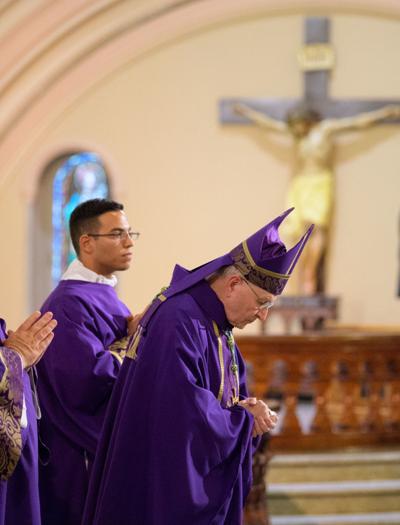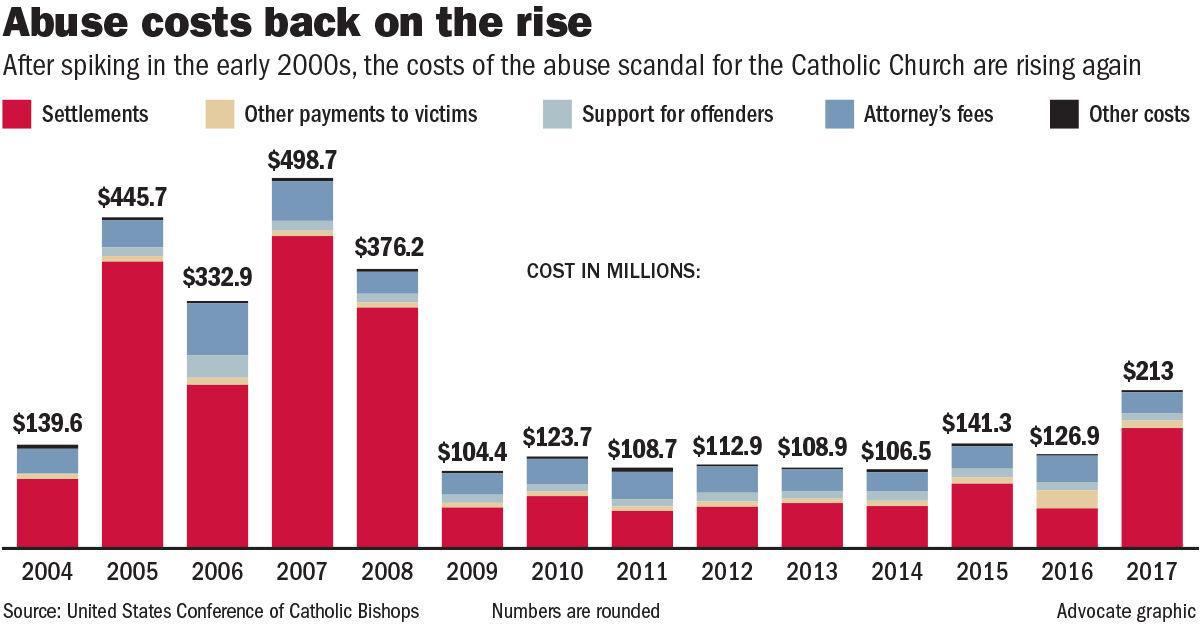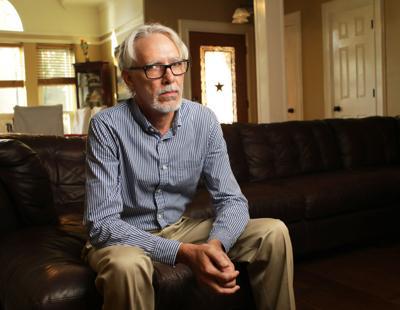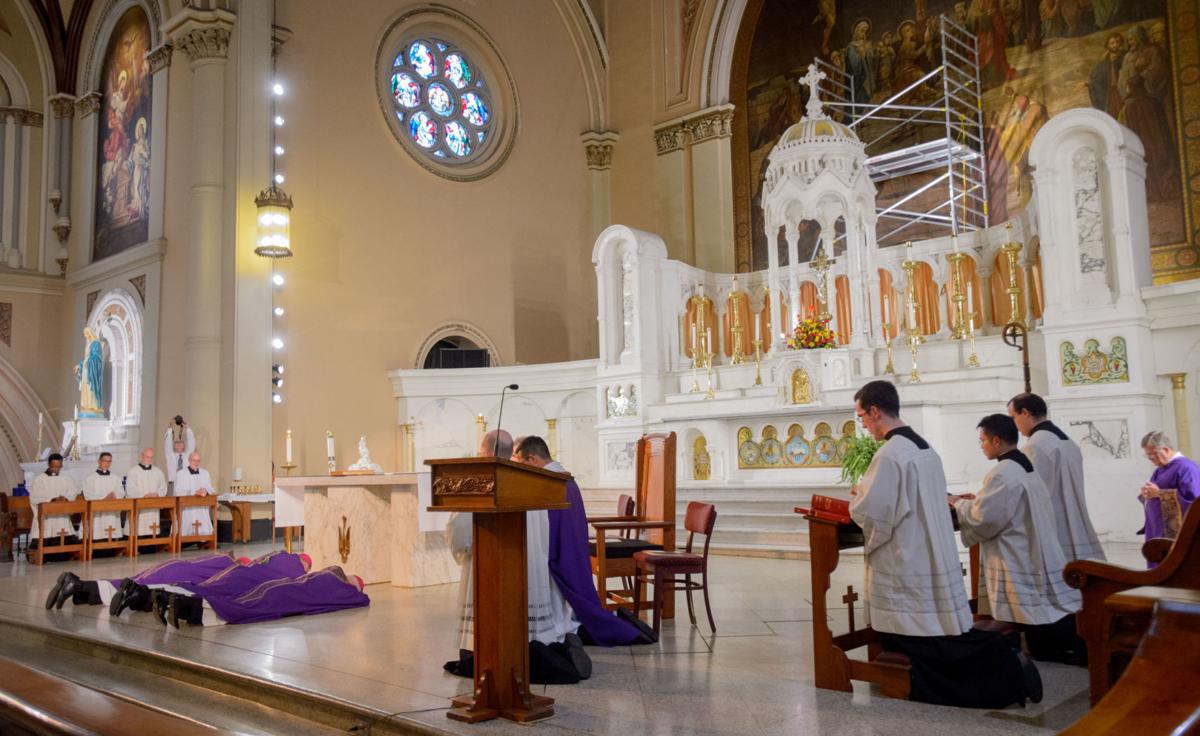|
For archdiocese, releasing names of Louisiana clergy accused of sex abuse can have financial toll
By Jerry Dicolo
Archbishop Gregory Aymond, clad in purple vestments symbolizing atonement, lay prostrate on the altar of St. Joseph Church during a special Mass of healing in August, a demonstration of contrition for the horrific acts of rape and abuse suffered by children at the hands of priests. His homily called for reflection on the sins of the Catholic Church. Standing before the faithful, he said, “As leaders of the church, it is time for us to repent.” So far, that confession has translated into weeks of public apology, but not the release of a full accounting of priests and other church leaders accused of sexual misconduct that many victims have demanded. Aymond and Louisiana's other bishops have said they are considering making such a list public, but they have not agreed on how or when. They have stressed the complicated nature of releasing the names, citing the desire to inform accused priests that they will be named, and issues related to clerics that have already died. What Aymond hasn't mentioned — at least publicly — is the cold financial calculus that inevitably weighs on the minds of church leaders when making decisions about transparency in the face of scandal. After a peak in the mid-2000s during the early years of the sexual-abuse scandal, annual costs to the church for settling abuse claims are again on the rise. U.S. dioceses spent over $212 million in 2017 due to the crisis, the highest figure since 2008, according to an annual report released by the U.S. Conference of Catholic Bishops. Since the extent of abuse across the church landscape was first revealed in 2002, 16 U.S. dioceses — or about one in every 12 — have declared bankruptcy or plan to do so because of multimillion-dollar settlements that left them with more debts than they could pay, according to the Massachusetts-based watchdog group BishopAccountability.org. For dioceses already struggling financially because of a decline in the number of practicing Catholics, the latest wave of sex-abuse claims has left bishops with a profound dilemma: how to accede to victims' demands for a full accounting of pedophile clergy, when doing so may mean millions of dollars in new claims and could lead to insolvency. “There’s no question that financial considerations play a big role in holding back the names,” said Jack Ruhl, a professor of accountancy at Western Michigan University, who has spent decades studying the finances of U.S. Catholic dioceses, including the Archdiocese of New Orleans. A recurring patternRuhl and other experts say that with each new report of abuse, more victims come forward and the potential payout rises. It is a pattern that has appeared in many dioceses over the past decade and a half — and one that recently resurfaced in New Orleans following the reports of settlements paid by the local archdiocese to victims of defrocked Metairie deacon George Brignac, and the abuse suffered by Richard Windmann at Jesuit High School in the 1970s. New Orleans attorney Roger Stetter, who has brought more than 100 claims against the Archdiocese of New Orleans and affiliated entities, said he has been contacted by 10 alleged victims over the past several months. The Advocate has been contacted by more than a dozen other alleged victims. The archdiocese, which spends approximately $48 million a year as the administrative hub for 111 church parishes and dozens of schools and other facilities, has millions of dollars worth of investments, real estate and other assets. But many of those funds have restrictions on how they can be used. And because operating deficits have totaled millions of dollars for most of the past decade, Aymond and other church leaders could find themselves in a precarious financial position if abuse claims jump sharply. Sarah McDonald, a spokeswoman for the archdiocese, said Aymond and other officials are hopeful that any future claims will not impact the myriad programs funded by the diocese, its parishes and other entities. "To date, we have been blessed that sexual misconduct claims have never had a financial impact on our ministries," she said. In addition, Archdiocese Chief Financial Officer Jeffrey Entwisle said that he expects insurance policies that existed during the peak of the abuse several decades ago will help cover any potential claims. 'Publicity is never good'Sexual abuse and molestation by clergy peaked in the late 1970s. Since then, incidents appear to have dropped dramatically, particularly after reforms were undertaken by U.S. bishops following the reporting about widespread abuse and cover-ups in Boston in 2002. Those reforms created policies and guidelines related to identifying and quickly removing credibly accused abusers from the church. Even still, victims of past abuse continue to come forward, year after year. Many of the settlements are being paid to people like Windmann, who grew up in New Orleans and was abused in the 1970s and 1980s, but did not settle his claims until recently. Charles Zech, former director of the Center for Church Management and Business Ethics at Villanova University, said that the costs of paying out abuse claims are primarily borne by individual dioceses, not the church hierarchy in Rome or insurance companies. Insurance covered just 13 percent of the abuse claims paid in 2017, according to the bishops’ report. For bishops in Louisiana, the financial risk that disclosure can bring is plain. After the release this summer of a Pennsylvania grand jury's report detailing credible claims against 300 priests across six of the state’s eight dioceses, media outlets reported a wave of new lawsuits and victims who planned to file claims. Abuse victims also have lobbied Pennsylvania lawmakers to extend a statute of limitations for abuse claims to allow them a chance to seek compensation. In 2014, the diocese of St. Cloud, Minnesota, released a full list of priests in the diocese believed to have abused children, according to the Minneapolis Star-Tribune. In January 2018, facing 74 claims of sexual abuse, the diocese announced it planned to seek bankruptcy protection. “The publicity is never good,” said Jason Berry, a New Orleans author and investigative journalist who has written extensively on Catholic sex abuse and church finances. He noted that several of the dioceses hit hardest by abuse claims in the past two decades, such as Boston, San Diego, St. Paul-Minneapolis and others, were forced to pay out tens or even hundreds of millions of dollars. The Archdiocese of St. Paul-Minneapolis finalized an agreement last month to pay $210 million to settle claims as part of a plan to reorganize itself through bankruptcy. Claims against other dioceses are still making their way through the courts. “The places that have filed Chapter 11 to reorganize — they are far wealthier than ones like New Orleans,” Berry said. Less than forthcomingAymond and his archdiocese have not always been forthcoming in releasing information about clergy sex abuse. Earlier this year, seemingly in violation of archdiocesan guidelines, the archdiocese quietly settled an abuse claim related to Brignac for about $500,000 without informing parishioners or the public until reports appeared in The Advocate. The archdiocese also has declined to provide an updated figure on the total size of recent settlements. Windmann, who recently decided to go public, was paid $450,000 in 2012 from the Jesuit order for abuse at the hands of a priest and janitor at Jesuit High School in the late 1970s. While this money wasn’t paid by the archdiocese, the publicity around the claim has caused more local people to come forward with their own stories of abuse. The financial pictures of most U.S. dioceses are rarely disclosed to parishioners or the general public, even though churchgoers' donations are the church's primary source of income. But the Archdiocese of New Orleans is different. Because it has issued publicly traded bonds through a state entity known as the Louisiana Public Facilities Authority, it is required to provide detailed, audited financial statements every year so that investors can gauge its financial health. It also provides some of this information on an annual basis in its own newspaper, The Clarion Herald, according to Entwisle. The financial statements suggest that under the leadership of Aymond and his predecessors, the archdiocese has built a sizable collection of valuable assets. At the end of fiscal year 2017, the archdiocese had a $286 million investment portfolio of stocks, bonds and other assets, over $75 million worth of real estate and undeveloped property, and nearly $7 million in cash. Still, debts are high, and many of those financial assets are restricted in how they can be used. For instance, $102 million of the archdiocese’s investment portfolio consists of “custodial funds.” These are often donations made by Catholics who gave the church money with certain conditions attached, such as a required annual distribution or a stipulation that the money must go to a particular charity. Another $103 million of the investments are deposits the archdiocese holds and invests for its parishes. Only around $88 million of the investments are “unrestricted,” meaning they can generally be used for any purpose the archbishop sees fit. The archdiocese’s real estate holdings are mostly churches, schools, nursing homes, administrative offices or other properties that the church uses to celebrate Mass, provide Catholic education or advance its charitable goals. While there is no legal restriction preventing the archdiocese from selling properties, the church’s canon law does not allow the archbishop to sell parish property unless the money stays within the parish, according to Villanova’s Zech. The archdiocese also owes its bondholders $43 million. Overall, the financial picture suggests that a settlement comparable in size to those paid out by some other dioceses would mean tough financial choices for Aymond and other church leaders. Self-insurance fundOne way Aymond has moved to protect the church is by setting aside another large chunk of money, $14 million or so, in a self-insurance fund dedicated to covering potential liabilities. Financial disclosure forms show the archdiocese created a separate legal entity, known as a captive insurance company, in 2011, to handle claims for which it didn’t — or couldn’t — buy insurance. The archdiocese can use those funds for routine insurance claims, such as traffic accidents or slip-and-fall cases. But the fund could also provide money to cover incidents of “personal misconduct” by priests and other employees of the archdiocese. Entwisle said that insurance policies from decades ago would also be called upon in the event of large settlements, but many factors, such as the year of the abuse, the premiums paid and the specific policy language from the time, would govern the extent to which claims are covered. Experts say there’s a reason that the archdiocese discloses select financial information through its own newspaper and a relatively obscure government database used by municipal bond investors: It's less likely that potential claimants will see it. Ruhl said that is particularly true when it comes to disclosing funds set aside for settlements, as that information offers a guide for victims and their attorneys to the payouts they could receive. “Whatever the amount is, they will want to keep that amount as low as possible, because survivors are going to look at the balance sheet,” he said. Stetter, the New Orleans attorney, is among those who have gained significant experience pursuing claims against the church over the past two decades. He said attorneys tend to focus on dioceses when pursuing claims of abuse because, as employers of priests and other parish or Catholic school employees, they bear the liability for any misconduct. The archdiocese is also where most church assets are held, he said. “Lawyers always think about who would be in the best position to pay in any judgment, or to settle the case. That is always a consideration,” he said. Stetter represented victims in one of the most notorious episodes of child abuse in the Archdiocese of New Orleans’ history, the beatings and molestation that occurred in the 1950s and 1960s at Madonna Manor and Hope Haven in Marrero. The archdiocese and another entity settled those claims in 2009 for $5.2 million, one of the largest settlements in the local church's history. The true costThe first decade of this century was among the most difficult periods in the history of the Archdiocese of New Orleans, which traces its founding to 1793 and is the second-oldest in the United States. Its roughly 500,000 Catholics make it a midsized diocese, comparable in size to the dioceses of Baltimore or Camden, New Jersey. Hurricane Katrina and the flooding that followed in 2005 caused hundreds of millions of dollars in damage to church property. Many churchgoers were outraged by the church closures and parish consolidations that followed soon thereafter, and the abuse crisis weighed on the church's reputation and finances. Before 2002, multimillion-dollar abuse settlements were very rare. In New Orleans, the archdiocese paid just $1.3 million in settlements from 1950 until 2003, according to a 2009 article in The Times-Picayune. But costs rose rapidly over the next several years. From 2003 to 2009, the archdiocese paid $12.6 million, according to the newspaper. Officials declined to provide an updated figure on more recent settlements. Many critics of the church insist on the need for complete transparency on the full scope of abuse. And some see bankruptcies and multimillion-dollar victim settlements as small compensation for the thousands of broken lives wrought by rape and abuse at the hands of priests and their protectors. "What I find is that they won’t tell the truth unless they are forced to; they won’t do the right thing unless they’re forced to," said Ruhl. "And you can't force them to do the right thing unless you take their money away or publicly humiliate them." But the cost of large settlements, even if justifiable, is ultimately borne by the communities of people who rely on the church for charitable assistance and the nurturing of their faith. The New Orleans archdiocese provides religious services for half a million Catholics, but it also serves many non-Catholics through its meal programs and work with the poor. Thousands of elderly people live in housing it helps to provide. And it serves as a moral voice on many issues concerning social justice. In other dioceses, large settlements have made it harder to find the money for programs that serve many disadvantaged people. “There are plenty of examples of dioceses laying off staff and closing programs after the settlements,” Zech said. “Someone has to pay, and it is ultimately the parishioners through reduced diocesan services.” In New Orleans, money is already tight. The archdiocese has posted operating losses for nine straight years. For fiscal year 2018, it expects to have revenues of nearly $38 million and expenses of just under $48 million, an operating loss of roughly $10 million, according to its 2018 budget estimates. After drawing down as much as 6 percent on its investment portfolio, it still expects to end 2018 in the red by nearly $6 million.
|
.
Any original material on these pages is copyright © BishopAccountability.org 2004. Reproduce freely with attribution.




